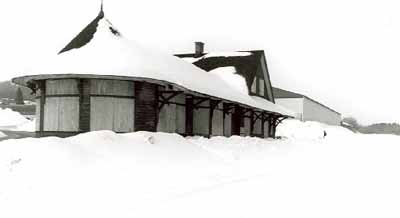Canadian Pacific Railway Station
Heritage Railway Station of Canada
Sainte-Agathe-des-Monts, Quebec

Rear elevation
(© Agence Parcs Canada / Parks Canada Agency, S. Bronson, 1994.)
Address :
24 St. Paul Street East, Sainte-Agathe-des-Monts, Quebec
Recognition Statute:
Heritage Railway Stations Protection Act (R.S.C., 1985, c. 52 (4th Supp.))
Designation Date:
1994-06-05
Dates:
-
1902 to 1902
(Construction)
-
1913 to 1913
(Addition)
Event, Person, Organization:
-
Canadian Pacific Railway
(Organization)
Research Report Number:
RS-224
Description of Historic Place
The Canadian Pacific Railway (CPR) station in Sainte-Agathe-des-Monts is a picturesque station with a distinctive circular waiting room that is joined to a high 1 ½ storey structure by a long central pavillion. It is located at 24 rue Saint-Paul East on a flat plain on the north edge of town surrounded by industrial buildings and its former railway yard.
Heritage Value
This station has been designated a heritage railway station for its historical, architectural and environmental significance.
Sainte-Agathe-des-Monts is situated on the CPR’s Montreal-Mont Laurier line which led to the development of the "Pays-d'en-Haut" north of Montreal. Access through rail transportation stimulated the growth of Sainte-Agathe-des-Monts as a village centre and a year-round tourism destination.
The CPR station in Sainte-Agathe-des-Monts was built in two parts: an initial 1902 station, and a 1913 addition. The initial station was a CPR “No 1 Standard Station (without dwelling)”, a long pavillion with a circular waiting room that the CPR was also to use in three Ontario communities. In all cases these were vacationland areas in which the waiting room with its distinctive conical roof drew attention to stations that were somewhat removed from the central part of town. In 1913 the station was enlarged by a modest 1 ½ storey addition containing a restaurant and stationmaster’s accomodation. It had a high pitched roof and was appended to the end of station opposite the conical roof, providing balance without detracting from its impact.
The heritage value of the CPR station at Sainte-Agathe-des-Monts resides in primarily in the distinctive form of its 1902 section with its round waiting room and conical roof. It also resides in the station’s 1902/1913 overall composition and siting.
Source:
· Heritage Character Statement, Canadian Pacific Railway Station, Sainte Agathe des Monts, Quebec, August 1994. Heritage Assessment Report RSR-224, 1993.
Character-Defining Elements
Character-defining elements of the Sainte-Agathe-des-Monts Canadian Pacific Railway Station include:
the distinctive footprint of the station with a long rectangular mid section, one circular end and one perpendicular rectangular end, its massing as a one storey central pavillion under a pitched roof with slightly bell-cast eaves, one single storey tower end under a conical roof with bell-cast edges, and one 1 ½ storey structure under a high pitched roof set at right angles to the main roof of the pavillion, the station’s distinctive profile, its late Victorian proportions, the balance inherent in its vertical definition, the alignment and rhythmic placement of apertures and brackets on the body of the building, the gazebo-like effect of the close placement of windows and windowlights on the tower, seemless integration of a telegrapher’s bay and platform cover into the building’s design, with the latter as a unifying device, the Tudor-like inspiration of the station’s picturesque details: tower end, conical roof, broad slightly bell-cast eaves, multi-paned windows, brackets, the varying textures of its original materials: wood cladding, shingle roof with metal details, wooden elements and decorative details, wooden windows and doors with multiple panes and panels, the station’s platform frame construction technology, all original fabric and furnishings inside the station, their forms, materials and finishes, including mouldings, doors, radiators and plumbing fixtures as well as those pieces finishing and furnishing the rooms, continued legibility of the station’s original functional and spatial configuration, particularly its general waiting room, ladies waiting room, telegrapher’s room, restaurant and living quarters, continuity of its longstanding access and circulation patterns, the overall integrity of the building’s form, plan, material, and detail.